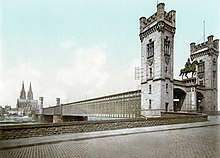Cathedral Bridge
|
Cathedral Bridge Dombrücke |
|
|---|---|

Cathedral Bridge, c. 1900
|
|
| Coordinates | 50°56′29″N 6°57′58″E / 50.941353°N 6.966062°ECoordinates: 50°56′29″N 6°57′58″E / 50.941353°N 6.966062°E |
| Carries | Two railway tracks, one two-way lane road |
| Crosses | River Rhine |
| Locale | Cologne, North Rhine-Westphalia, Germany |
| Owner | Cologne-Minden Railway Company |
| Followed by | Hohenzollernbrücke |
| Characteristics | |
| Design | Lattice truss bridge |
| Material | Wrought iron (truss) |
| Width | 16.73 metres (54.9 ft) Railway deck: 8.16 metres (26.8 ft) Road deck: 8.47 metres (27.8 ft) |
| Longest span | 103.2 metres (339 ft) |
| No. of spans | 2 × 19.85 metres (65.1 ft) 4 × 103.2 metres (339 ft) |
| History | |
| Architect | Johann Heinrich Strack |
| Designer | Friedrich Wilhelm Wallbaum |
| Engineering design by | Hermann Lohse |
| Construction begin | 1855 |
| Construction end | 1859 |
| Construction cost | 4 million Thalers (estimate) |
| Inaugurated | 3 October 1859 |
| Closed | 1909 |
The Cathedral Bridge (German: Dombrücke pronounced [ˈdoːmˌbʁʏkʰə]) was a railway and street bridge crossing the river Rhine in the German city of Cologne. It was owned by the Cologne-Minden Railway Company and named after the Cologne Cathedral, which is located on the same longitudinal axis. It was built in combination with the original Central Station (German: Zentralbahnhof pronounced [tsɛnˈtʰʁaːlˌbaːnɦoːf]) and a new ground-level railway track through the north Altstadt of the Cologne Innenstadt. As the Cathedral Bridge could not bolster the increased traffic of the new Köln Hauptbahnhof in 1894, it was replaced by the Hohenzollern Bridge in 1911.
The Cathedral Bridge was the second railway bridge to be built over the river Rhine, after the significantly shorter Waldshut–Koblenz Rhine Bridge with spans of up to 52 metres (171 ft), which was opened just a few months prior on 18 August 1859.
The Prussian authorities pressed for a bridge due to increasing road traffic between Cologne and the eastern river bank. Before the Cathedral Bridge, passengers and goods had to be transported across the river by reaction ferry or pontoon bridge. The city council filed a request with Frederick William IV of Prussia in 1847, who through the Ministry of Trade, Commerce and Public Works appointed the Prussian chief civil engineer Karl Lentze to design the bridge.
...
Wikipedia
